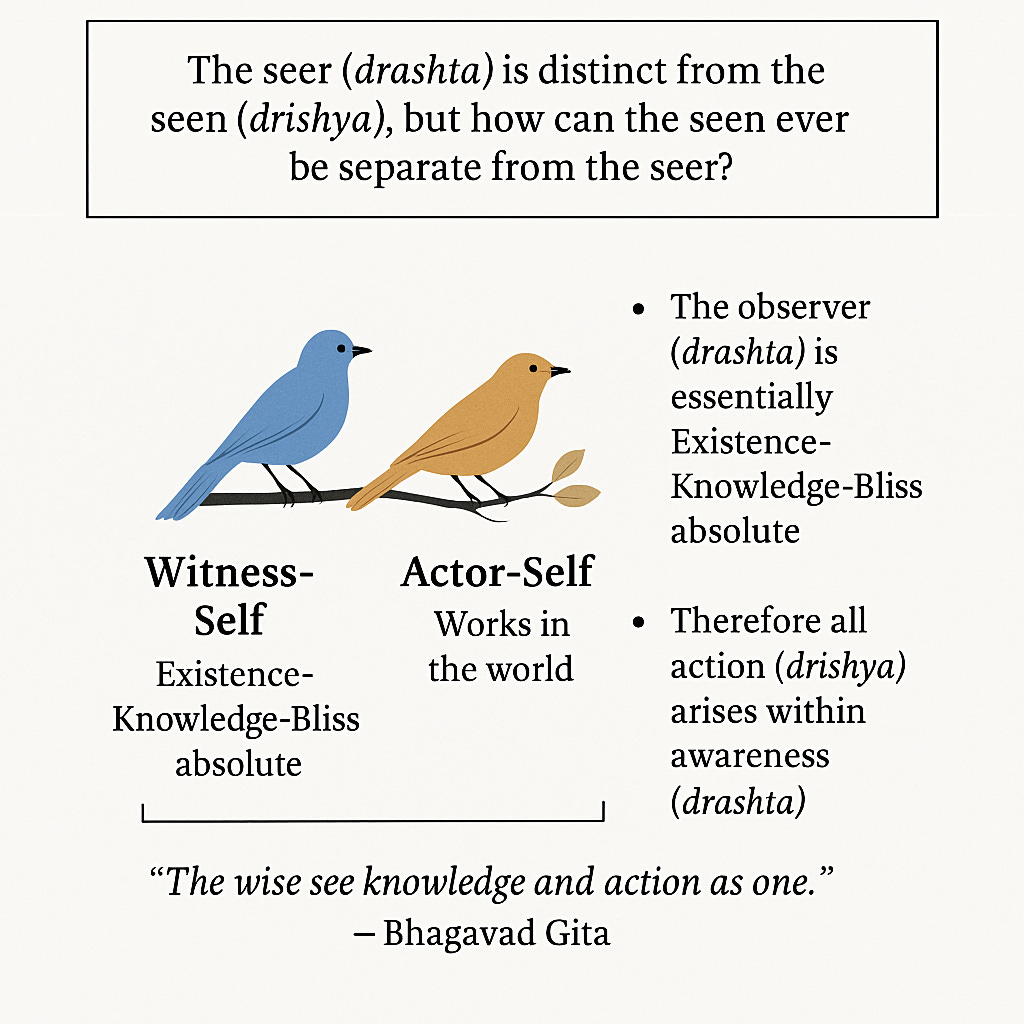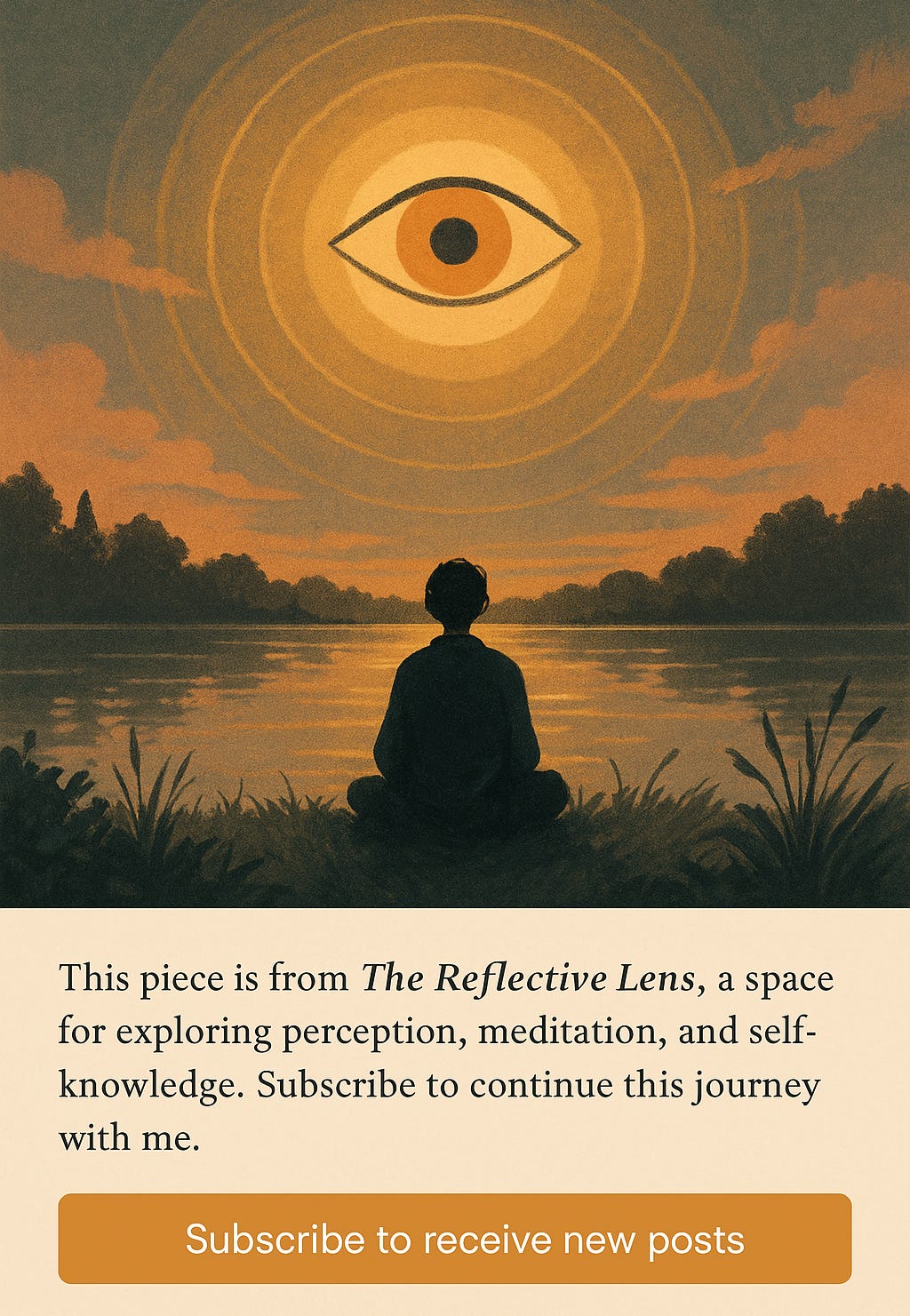The dance of the seer and the seen
Rediscovering unity between knowledge, action, and graceful living
There’s a teaching in the Bhagavad Gita that has long intrigued me:
“The wise see knowledge and action as one and the same.” 1
How can this be?
Isn’t knowledge (Jnana) the quiet pursuit of truth, while action (Karma) is the chaotic dance of life? The paths seem worlds apart, one rooted in stillness and introspection, the other in movement and engagement.
And yet, these words in the Gita began to make sense when I saw them through the lens of Vedanta and a striking metaphor from the Mundaka Upanishad:
“Two birds sit on the same tree. One eats the sweet and bitter fruits, the other simply watches.” 2
These birds aren’t just poetic imagery—they’re the keys to understanding the depths of our own being.
The bird that eats is the actor-self, the part of us that thinks, chooses, acts, and experiences life’s joys and sorrows.
The bird that watches is the witness-self, the still awareness untouched by the sweetness or bitterness of outcomes.
Together, these birds reveal something profound: while the actor-self moves, it is the witness-self—the foundation—that simply is. In Vedanta, this witness-self is described as Sat-Chit-Ananda: Existence, Knowledge, Bliss Absolute3. It is luminous awareness, unchanging and eternal — and is a positive definition of “I” that is Us! 😄
Here’s where the metaphor evolves into a radical realization. A line in Hindi flipped the idea on its head for me:
“Drashta drishya se alag hai, par drishya drashta se kaise alag ho sakta hai?”4
“The seer is distinct from the seen, but how can the seen ever be separate from the seer?”
We often think of separating ourselves from thoughts, emotions, and sensations as the path to freedom. One has to do that, to appreciate the Drashta, but at the same time the above teaching shows us the fine nuance behind it, that is, Drishya irrespective is not different from Drashta: or even simply put, the World arises within Awareness.
Just as a dream cannot exist apart from the dreamer or a movie apart from its screen, the seen has no existence outside of the seer. Even the actor-self is simply movement within the still Witness-Self.
Now the Gita’s teaching about knowledge and action becomes clear. When action arises from the awareness of our true nature—this witness-self that is luminous and blissful—then action flows effortlessly, without ego or attachment. It becomes Karma Yoga: action rooted in wisdom, unbound by results.
Action and Knowledge are no longer separate; you don’t shift between wisdom and movement—you act from wisdom itself. The two birds become one being, expressing itself in two ways: stillness and movement, introspection and participation.
This perspective transforms how we live.
You don’t need to retreat from the world to be spiritual or shut down action to discover wisdom. Instead, shift your identity from the actor lost in the fruits of action to the witness from whom all actions gracefully flow. When one act’s from this center, every movement becomes sacred, and worldly life merges seamlessly with spiritual life. You move like the wind, but remain rooted in the sky.
Maybe this is the Gita’s ultimate promise: to live fully in the world as the doer, while resting in the eternal truth that you are the witness.
To move beyond theory and ground this understanding in real-life experience, we turn to Sri Ramakrishna’s5 teaching: “Brahman and Shakti are inseparable.” This profound insight brings us to the very essence of unity, offering a practical pathway to recognize and embody the harmony between stillness and action in our everyday lives.
The drishya, the seen world—the thoughts, emotions, sensations, and all the dynamic movements of life—is Shakti Herself 6. Shakti is the vibrant, creative energy that animates all existence, and Vedanta reveals that this energy is not outside or apart from the ultimate reality of Brahman. The profound truth lies in the fact that drishya cannot exist independently of drashta, the seer. Just as we established earlier, the seen arises within the seer; it is Shakti emerging within and through Brahman.
This realization tallies with Sri Ramakrishna’s insight: Shakti is none other than Brahman.
While Shakti is the expressive force—the movement and dynamism of creation—Brahman remains the still, unchanging awareness that holds it. They are not two separate entities, but one unified reality expressing itself in complementary ways. As Sri Ramakrishna succinctly put it, “Shakti does everything, but Brahman remains still.”7
Sri Ramakrishna’s life was a living testament to this truth. Once, while worshipping the Divine Mother Kali, he entered such an intense state of devotion that he saw everything around him, from the image on the altar to the humble objects of daily life, as infused with Her presence8. To him, the drishya—the seen—was Shakti, not separate from the luminous stillness of Brahman. This vision of divine unity was not an abstract idea for him; it was his lived reality. His reverence for all things, big and small, reflected this understanding.
This teaching dissolves any artificial boundaries between the observer and the observed, stillness and movement, or knowledge and action. The drishya is Shakti—the divine energy pervading all things—and because it arises inseparably from drashta, the eternal Brahman, every experience, every action, becomes an expression of sacred unity.
To see this truth is to recognize the seamless flow of creation, where movement and stillness, action and awareness, are two facets of one infinite essence.
And here, Sri Sarada Devi’s9 teaching deepens the promise: Everything in the world is deified. She once showed concern for a broom(!!), an object so humble that it is easy to overlook its sacredness. Yet her act reminds us that no part of existence is devoid of divinity—every atom, every action, every tool we use, carries the essence of Shakti.10
In her daily life, Sarada Devi demonstrated this truth effortlessly. Whether she was performing household chores, offering advice to devotees, or silently meditating11, her actions carried the same sacred energy. She embodied the teaching that no task is too small to be divine, no object too insignificant to reflect the ultimate reality.
This is what it means to truly see the unity between Brahman and Shakti, the seer as the seen, stillness as movement. To engage with the world as if every interaction, every movement, is imbued with sacred energy.
To live this truth is to see the divine in all things. Even the simplest actions become part of Shakti’s cosmic dance. You move through life knowing that the world you engage with is not separate from the Self. Every action arises from, and returns to, the luminous stillness of Brahman.
And maybe this is why the wise see knowledge and action as one and the same. In the ultimate reality, there is no separation—only the effortless flow of Brahman as Shakti, the seer as the seen and stillness as movement.
Bhagavad Gita, Chapter 5, Verse 4.
Mundaka Upanishad, 3.1.1.
Sat-Chit-Ananda is a central concept in Advaita Vedanta, referring to the essential nature of ultimate reality.
Traditional Hindi teaching on drashta and drishya—often shared in Vedantic commentaries.
Sri Ramakrishna Paramahamsa (1836–1886) was a mystic and saint of 19th-century Bengal, revered as one of the greatest spiritual teachers of modern India. Known for his intense devotion to the Divine Mother Kali, he experienced profound states of spiritual ecstasy and exemplified the unity of all religious paths. His teachings, recorded in The Gospel of Sri Ramakrishna, continue to inspire seekers worldwide.
Shakti is often described in Tantric and Vedantic traditions as the dynamic creative power of Brahman.
Ramakrishna Paramahamsa, in his teachings, often emphasized the unity of Brahman and Shakti as inseparable truths.
Ramakrishna’s intense experiences during Kali worship are documented in The Gospel of Sri Ramakrishna.
Sri Sarada Devi (1853–1920), also known as the Holy Mother, was the spiritual consort of Sri Ramakrishna and a revered saint in her own right. She exemplified boundless compassion, simplicity, and wisdom, offering spiritual guidance to countless seekers. Her life was a testament to living the highest spiritual ideals within the humblest of daily actions, and she remains a source of inspiration for those walking the path of devotion and selfless service.
Sri Sarada Devi’s concern for a broom is a well-known anecdote highlighting the sanctity of all things.
Sarada Devi’s life exemplified the merging of the mundane and the divine—captured in numerous biographies such as Sri Sarada Devi, The Holy Mother.





